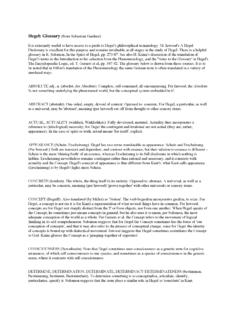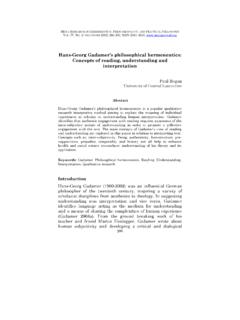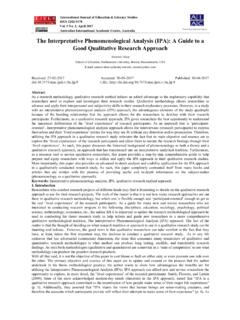Transcription of Understanding Psychopathology - SAGE Publications Inc
1 1 Understanding PsychopathologyLEARNING OBJECTIVES FOR THIS CHAPTER Understand what Introducing Psychopathology is about Know the history behind the concept of Psychopathology Discuss the philosophical underpinnings of Psychopathology Have insight into the classification of mental disorders Realise that cultural and transcultural issues are involved in psychopathologyAt the heart of counselling, psychotherapy and counselling psychology lies an Understanding of mental distress. This is why knowledge of Psychopathology is crucial for trainees entering these professions.
2 Without it, they can get lost in a maze of I was a student, I wished for a book that explained mental disorders in a jargon-free, simple way. During my training, ploughing through the great third edition of the Diagnostic and Statistical Manual for Mental Disorders (APA, 1987) was a daunting task. What I needed was a sim-ple introduction to Psychopathology . I write the simply presented and jargon-free book I wish I had in the hope that it helps those who use (or will use) talking as a therapeutic tool with their clients or having the ability to be a reflective practitioner is key (as I explain later in this chapter), without a breadth and depth of Understanding how mental distress manifests in individuals, coupled with a knowledge from theory and research on how to facilitate these people to move in a desired direction, the therapeutic relationship is severely compromised.
3 If indeed, it is present at all. Without such knowledge and Understanding , therapists may unwittingly make matters worse. Bearing this in mind, Introducing Psychopathology specifically includes points to reflect on. There are teaching and learning features throughout and these are discussed further on. You do not have to read this book in any particular order. Dip into it at any place. Each chapter can stand in its own right if you want to find out about being depressed, just go to the chapter that deals with depression.
4 Nevertheless, there is some logic to the order I have written the text. For instance, this chapter is the book s introduction. The one that follows deals with assessing and referring, because these tasks are normally necessary during a first appointment. Then there is a focus on children before the spotlight shines on adults, and finally I consider possible future avenues. Therefore, you can read Introducing Psychopathology from cover to cover for a more comprehensive 110/4/2013 10:04:13 AMIntroducing Psychopathology2 WHAT IS Psychopathology ?
5 Psychopathology derives from two Greek words: psyche meaning soul , and pathos meaning suffering . Currently, Psychopathology is understood to mean the origin of mental disorders, how they develop and their symptoms. Traditionally, those suffering from mental disorders have usually been treated by the psychiatric profession, which adheres to the DSM-IV-TR (APA, 2002) or ICD-10 (WHO, 1992) for classifying mental disorders. It therefore follows that psychiatrists use the term Psychopathology more than people in other professions.
6 Psychiatrists are medical doctors who then train in mental health and are able to treat with medication or/and in whatever psychotherapy model they have trained in. Within psychiatry, the term pathology refers to disease. However, viewing mental problems as a disease is a contentious point. Psychotherapists, counselling psychologists and counsellors (who specialise in mind matters and are not medics), view apparent mental dysfunction as men-tal distress, not necessarily related to pathology. So, the term disorder is used, rather than disease.
7 Other words for diagnosing distress within the mind remain: symptoms meaning signs , aetiology meaning cause , and prognosis meaning expected outcome .HISTORY AND PHILOSOPHYH istorical and philosophical factors of Psychopathology can easily take up a whole volume. This section offers a Psychopathology foundation, which can be built on by looking up the related resources and references listed at the end of the chapter. Historically, the concept of Psychopathology is rooted in the medical tradition. This is where the terms diagnosis , symptoms , aetiology and prognosis come from (Murphy, 2010).
8 Psychiatrists cat-egorise severe mental distress into psychopathological disorders whose symptoms they can treat with prescribed drugs, and use the word patients . Counselling psychologists, counsellors and psycho-therapists favour the term clients over patients (because of the medical connotations of the word patients ) and use talking, more than anything else, as a therapeutic tool . They also prefer the concept of formulation instead of diagnosis, symptoms, aetiology and prognosis . Throughout this book, instead of repeating counselling psychologists, counsellors and psycho therapists , I use the word therapists , or talking-cures to mean all three of these professions because although they may require different trainings, their overlap is substantial.
9 But what are the historical roots of these professions?Ancient GreeceMedical and talking-cure roots are embedded in the soil of ancient Greek philosophy. Indeed, the philosophy of the western world is rooted in ancient Greece, from which the mould of western-world thinking was wrought, influencing the way in which the west is. Therefore it follows that the source of my views grows from this mould, which shapes my world and con-sequently this book, because I was born, raised and live in the west. If I visit a non-western country, the cross-cultural differences may be too great for me to comprehend.
10 I might think that I understand someone whose philosophical template is embedded within a non-western philo-sophy, but I may, in my relative ignorance, misunderstand that person. For this reason, the philosophy focused on here relates to the western world. Nevertheless, as therapists in multicultural settings, we need to be aware of a client s culture and adapt appropriately. 210/4/2013 10:04:13 AMUnderstanding Psychopathology3It is possible to trace two fine philosophical threads stemming from the ancient Greek philosophers Plato and Aristotle (Plato s student) to the present day.














